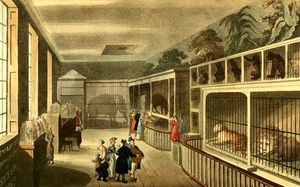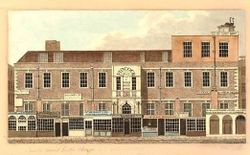Exeter Exchange

The Exeter Exchange (commonly known as the Exeter 'Change) was built in 1676, on the north side of The Strand in London, almost opposite the Savoy Hotel. From 1773, the upper rooms were let out to a series of impresarios who operated a menagerie, competition to the menagerie at the Tower of London. At various times, this included monkeys, lions and tigers and various other exotic species, confined (as was common at the time) iron cages in small rooms. It was not uncommon for horses passing in the road outside to be spooked by the roaring of the big cats.
The menagerie was initially established by Thomas Clark, but it was purchased in 1793 by Gilbert Pidcock and then it passed to the ownership of Stephani Polito in 1810. Pidcock and Polito were both owners of travelling circuses and used the premises as winter quarters for their animals.
According to Ackermann's Repository of July 1812, the animals on display at the time included a Bengal tiger, a hyena, a lion, a jaguar, a sloth, a camel, monkeys, a hippopotamus, a rhinoceros, an elephant, an ostrich "said to weigh upwards of 200lbs and to be 11 feet high”", a cassowary, a pelican, "emews", cranes, an eagle, cockatoos, elks, kangaroos and antelopes. One of the star attractions was Chunee, an Indian elephant which had arrived in England in 1809, had performed at the Theatre Royal, Covent Garden and was often paraded in the streets outside the menagerie itself.
The 'Change in LL
- Emma Vickery visited the menagerie when she was a debutante[1]
- Anthony Dunford, Elizabeth Dunford and Annabelle Beacham visited the 'Change on the 26th April 1811[2]
- Annabelle Beacham mentions her visit there in conversation with Frederick Lazenby[3]
- Robbie Fitzgerald recommends the 'Change as a place Lady Hollomere might like to take her sister[4]
- Elise Hampton dismisses the 'Change as a place Robbie Fitzgerald could visit, due to his injury[5]
- Kenward Asquith ponders taking his nephews Horatio and Tristram to visit the 'Change [6]
References
Wikipedia: The Exeter Exchange
Regency History: The Royal Menagerie at Exeter Exchange
<references>
